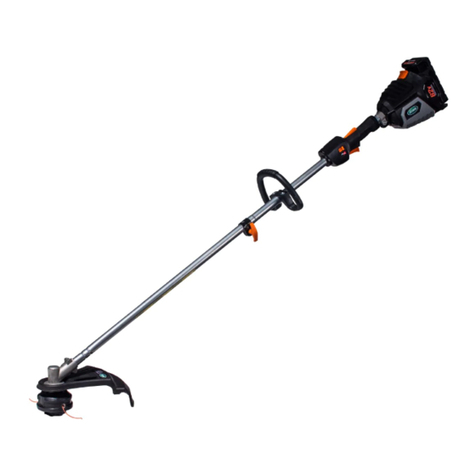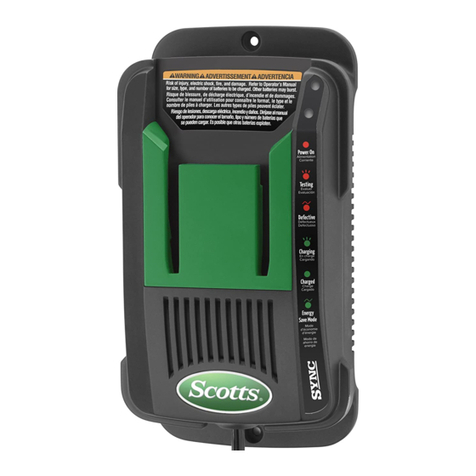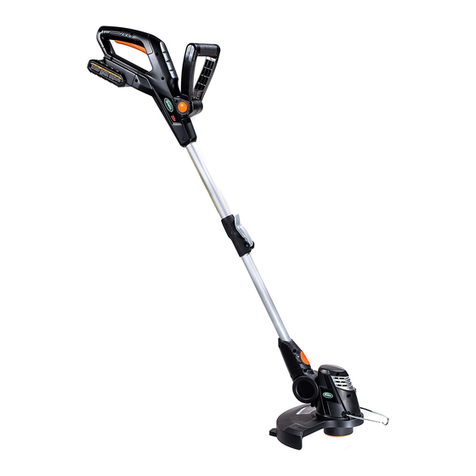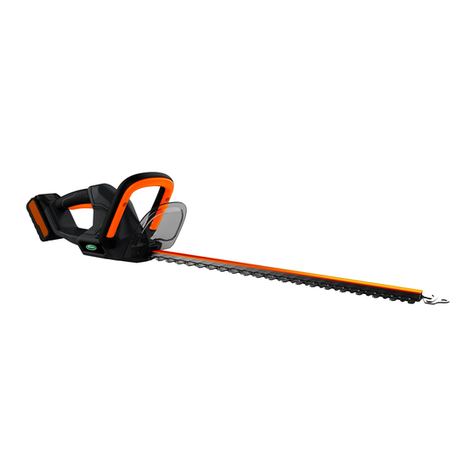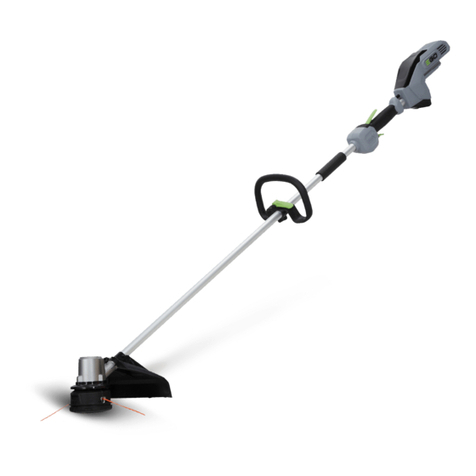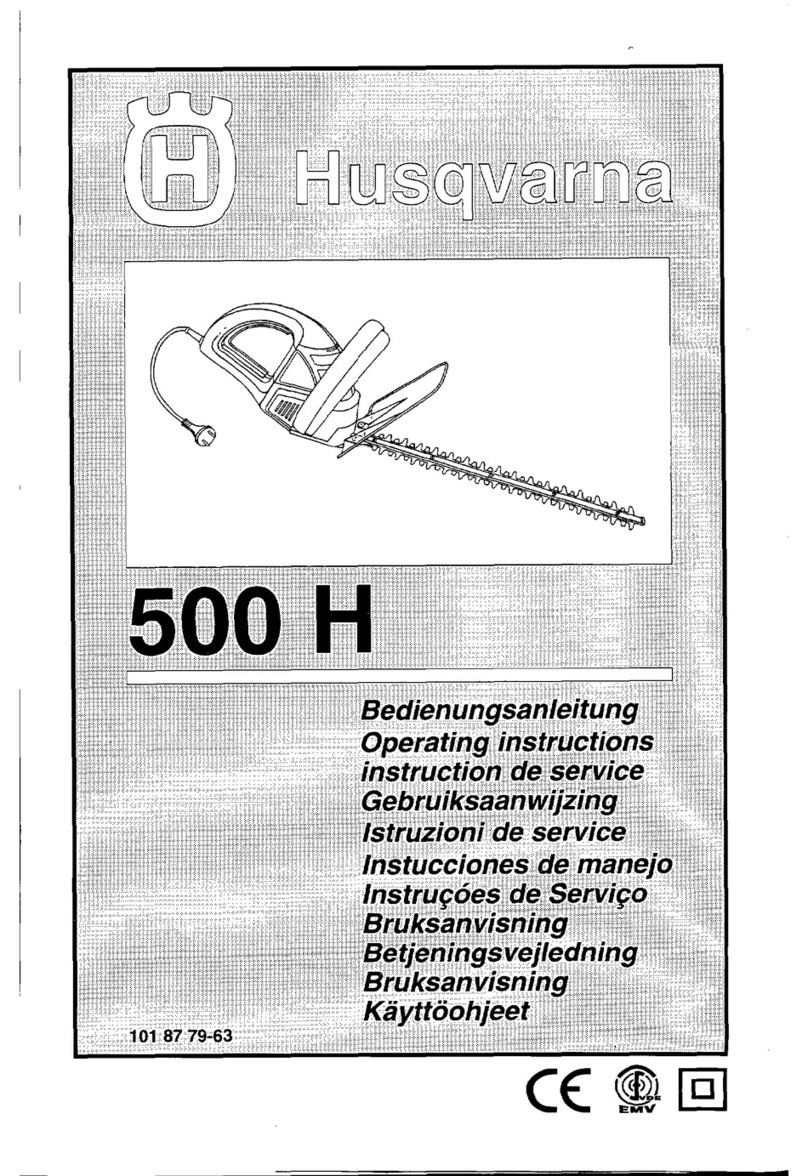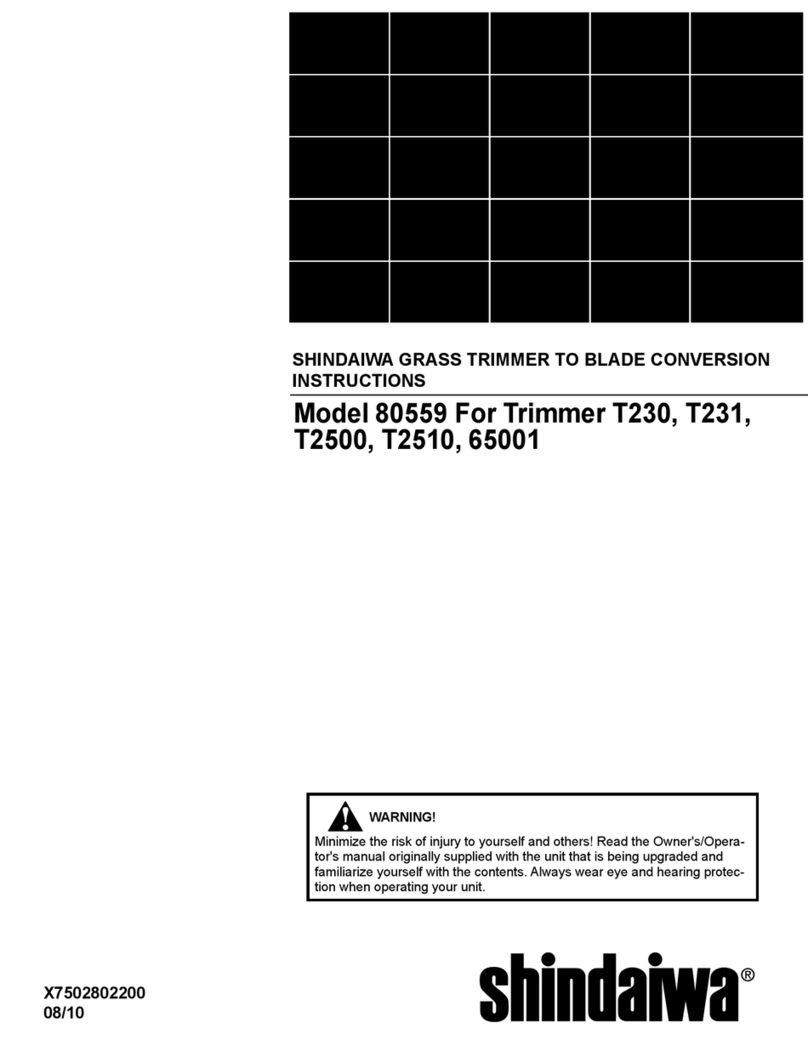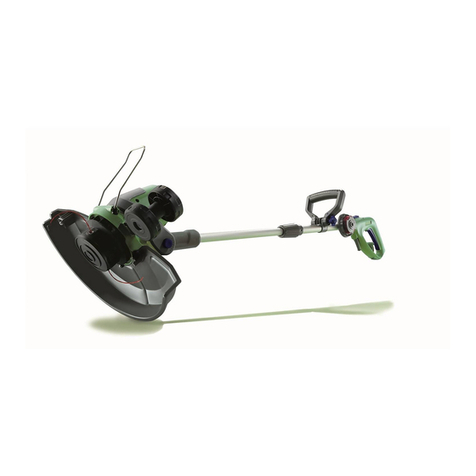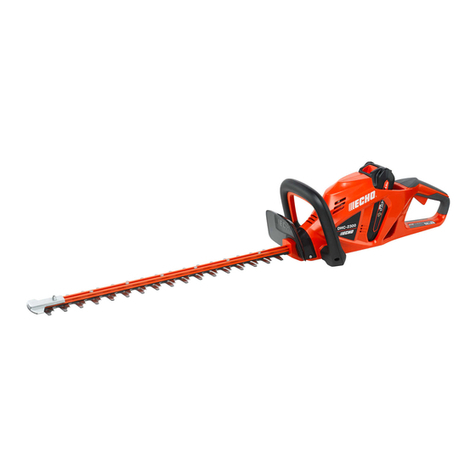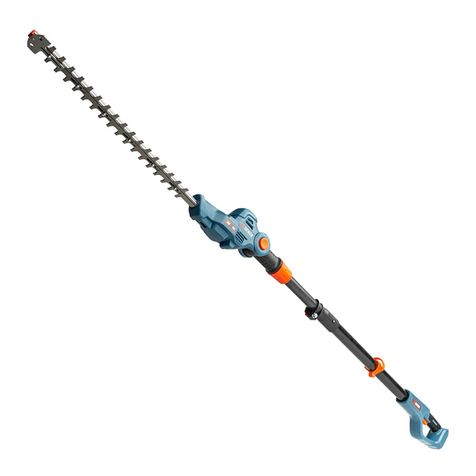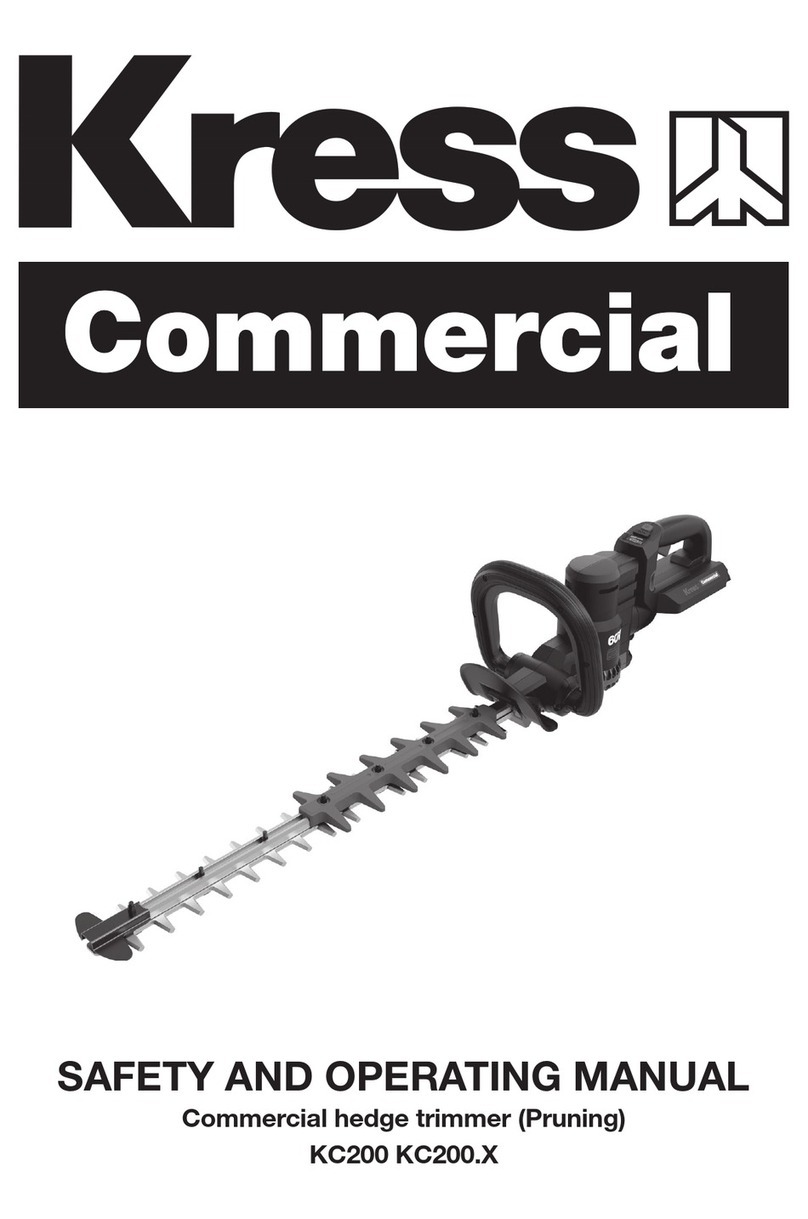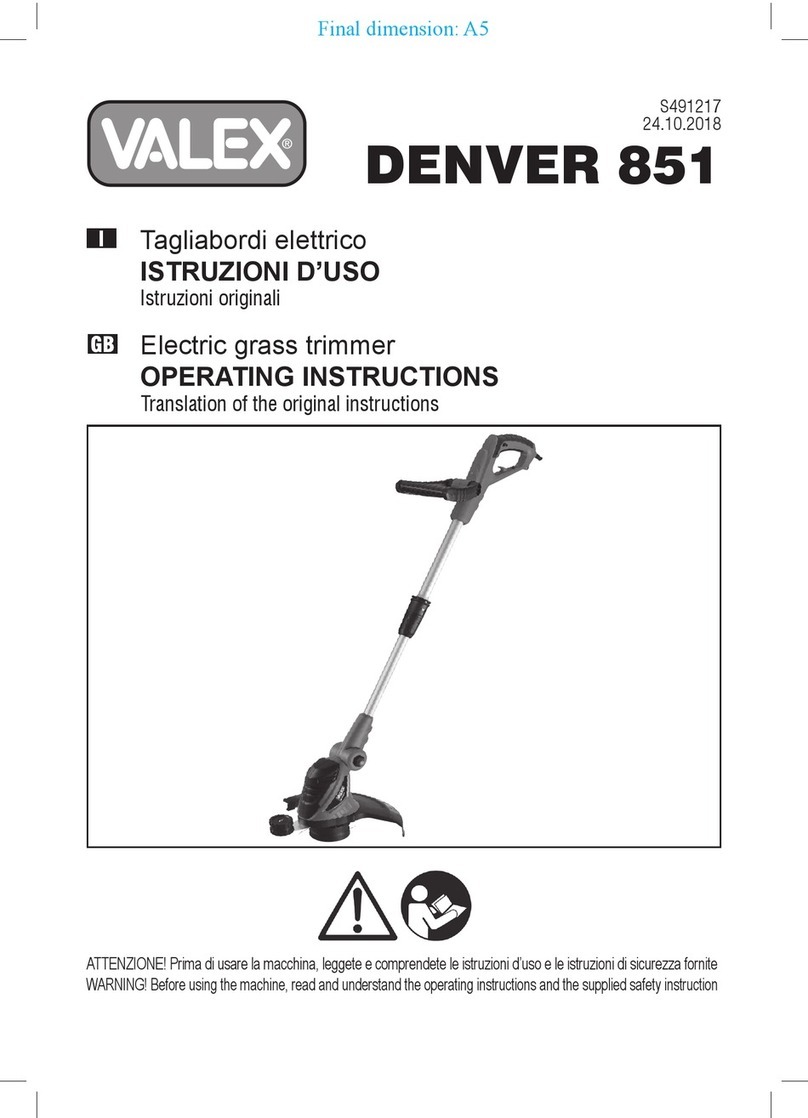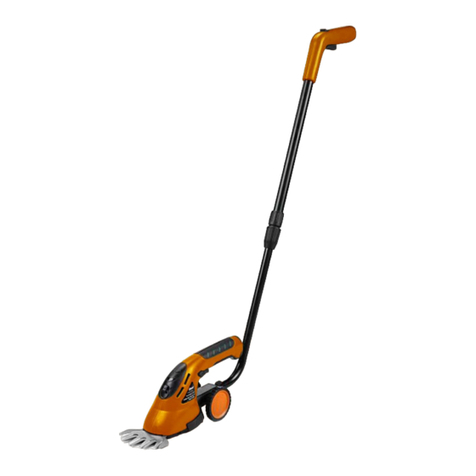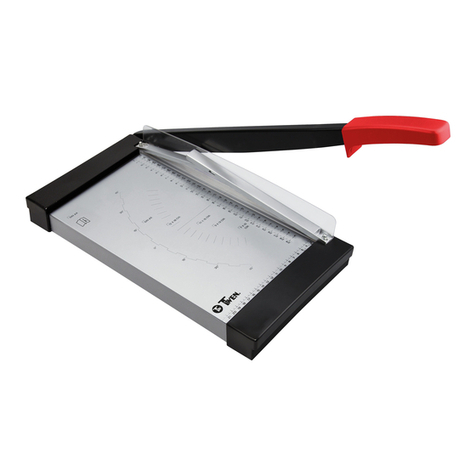Scotts S20600 User manual

S20600
20 Volt Hedge Trimmer
Taille-Haies 20 V
Podadora de Setos de 20 V
ACCEPTS ALL SCOTTS®20V BATTERY PACKS
BATTERIES AND CHARGERS SOLD SEPARATELY
COMPATIBLE AVEC TOUTES LE BLOC-PILES SCOTTS®DE 20 V
PILE ET CHARGEUR VENDUS SÉPARÉMENT
ACEPTA TODAS LOS PAQUETES DE BATERÍAS SCOTTS®DE 20 V
LAS BATERÍAS Y EL CARGADOR SE VENDEN POR SEPARADO
SAVE THIS MANUAL FOR
FUTURE REFERENCE
WARNING: To reduce the risk
of injury, the user must read and un-
derstand the operator’s manual before
using this product.
ADVERTENCIA: Para reducir
elriesgodelesiones,elusuariodebeleer
y comprender el manual del operador
antes de usar este producto.
AVERTISSEMENT :
Pour
réduire les risques de blessures,
l’utilisateur doit lire et veiller à bien
comprendrelemanuel d’utilisation avant
d’employer ce produit.
TABLE OF CONTENTS
****************
General Power Tool
Safety Warnings ..............................2-3
Hedge Trimmer Safety Warnings ....... 3
Symbols ..........................................4-5
Features ............................................. 6
Assembly............................................ 6
Operation ........................................7-8
Maintenance....................................8-9
Warranty........................................... 10
Parts Ordering and
Service ................................Back Page
TABLE DES MATIÈRES
****************
Instructions de sécurité
générales pour outils électriques....2-3
Avertissements de sécurité
pour la taille-haies..............................3
Symboles ........................................4-5
Caractéristiques.................................6
Assemblage .......................................6
Utilisation ........................................7-8
Entretien..........................................8-9
Garantie ...........................................10
Commande de pièces
et réparation......................Page arrière
ÍNDICE DE CONTENIDO
****************
Advertencias de seguridad
para herramientas eléctricas ......... 2-3
Advertencias de seguridad
para podadora de setos ....................3
Símbolos........................................ 4-5
Características...................................6
Armado..............................................6
Funcionamiento............................. 7-8
Mantenimiento............................... 8-9
Garantía ...........................................10
Pedidos de piezas
y servicio.......................Pág. posterior
CONSERVER CE MANUEL
POUR FUTURE RÉFÉRENCE
GUARDE ESTE MANUAL
PARA FUTURAS CONSULTAS
OPERATOR’S MANUAL
MANUEL D’UTILISATION
MANUAL DEL OPERADOR

ii
See this fold-out section for all of the figures referenced
in the operator’s manual.
Consulter l’encart à volets afin d’examiner toutes les figures
mentionnées dans le manuel d’utilisation.
Consulte esta sección desplegable para ver todas las figuras a
las que se hace referencia en el manual del operador.
Fig. 1 Fig. 2
Fig. 3
A - Blades (lames, hojas)
B - Scabbard (fourreau, funda)
C - Guard (garde, protección)
D - Front handle (poignée avant, mango
delantero)
E - Battery fuel gauge (indicateur de niveau de
pile, indicador de carga de la batería)
A - Battery pack (bloc-piles, paquete de
baterías)
B - Latches (loquets, pestillos)
A
B
A
B
CD
F
E
G
H
F - Trigger lock-out (verrouillage de gâchette,
seguro del gatillo)
G - Rear Handle with overmold (poignée arrière
avec surmoulage, mango trasero con
sobremoldeado)
H - Switch trigger (gâchette, gatillo)

iii
Fig. 4
Fig. 5
A - Trigger lock-out (verrouillage de gâchette,
seguro del gatillo)
B - Switch trigger (gâchette, gatillo del
interruptor)
Fig. 6
Fig. 7
Fig. 8
Fig. 9
A - Cutting teeth (dents de coupe, dientes de
corte)
B - Guard teeth (dents de coupe, dientes de
proteción)
Fig. 10
A - Scabbard (fourreau, funda)
A
B
B
A
PROPER OPERATING POSITION
BONNE POSITION DE TRAVAIL
POSICIÓN CORRECTA PARA EL MANEJO
DE LA HERRAMIENTA
A

2 — English
WARNING
Read all safety warnings and all instructions. Failure to
follow the warnings and instructions may result in electric
shock, fire and/or serious injury.
Save all warnings and instructions for future reference.
The term “power tool” in the warnings refers to your mains-
operated (corded) power tool or battery-operated (cordless)
power tool.
WORK AREA SAFETY
Keep work area clean and well lit. Cluttered or dark
areas invite accidents.
Do not operate power tools in explosive atmospheres,
such as in the presence of flammable liquids, gases
or dust. Power tools create sparks which may ignite the
dust or fumes.
Keep children and bystanders away while operating a
power tool. Distractions can cause you to lose control.
ELECTRICAL SAFETY
Power tool plugs must match the outlet. Never modify
the plug in any way. Do not use any adapter plugs with
earthed (grounded) power tools. Unmodified plugs and
matching outlets will reduce risk of electric shock.
Avoid body contact with earthed or grounded surfaces
such as pipes, radiators, ranges and refrigerators.
There is an increased risk of electric shock if your body
is earthed or grounded.
Do not expose power tools to rain or wet conditions.
Water entering a power tool will increase the risk of electric
shock.
Do not abuse the cord. Never use the cord for carrying,
pulling or unplugging the power tool. Keep cord away
from heat, oil, sharp edges or moving parts. Damaged
or entangled cords increase the risk of electric shock.
When operating a power tool outdoors, use an
extension cord suitable for outdoor use. Use of a cord
suitable for outdoor use reduces the risk of electric shock.
If operating a power tool in a damp location is
unavoidable, use a ground fault circuit interrupter
(GFCI) protected supply. Use of a GFCI reduces the risk
of electric shock.
PERSONAL SAFETY
Stay alert, watch what you are doing and use common
sense when operating a power tool. Do not use a power
tool while you are tired or under the influence of drugs,
alcohol or medication. A moment of inattention while
operating power tools may result in serious personal injury.
Use personal protective equipment. Always wear eye
protection. Protective equipment such as dust mask,
non-skid safety shoes, hard hat, or hearing protection
used for appropriate conditions will reduce personal
injuries.
GENERAL POWER TOOL SAFETY WARNINGS
Prevent unintentional starting. Ensure the switch is in
the off-position before connecting to power source
and/or battery pack, picking up or carrying the tool.
Carrying power tools with your finger on the switch or
energising power tools that have the switch on invites
accidents.
Remove any adjusting key or wrench before turning
the power tool on. A wrench or a key left attached to a
rotating part of the power tool may result in personal injury.
Do not overreach. Keep proper footing and balance at
all times. This enables better control of the power tool in
unexpected situations.
Dress properly. Do not wear loose clothing or jewellery.
Keep your hair, clothing and gloves away from moving
parts. Loose clothes, jewellery or long hair can be caught
in moving parts.
If devices are provided for the connection of dust
extraction and collection facilities, ensure these are
connected and properly used. Use of dust collection
can reduce dust-related hazards.
Do not wear loose clothing or jewelry. Contain long
hair. Loose clothes, jewelry, or long hair can be drawn
into air vents.
Do not use on a ladder, rooftop, or unstable support.
Stable footing on a solid surface enables better control
of the power tool in unexpected situations.
Wear heavy, long pants, long sleeves, boots, and
gloves. Do not wear loose fitting clothing, short pants,
sandals, or go barefoot. Do not wear jewelry of any kind.
POWER TOOL USE AND CARE
Do not force the power tool. Use the correct power tool
for your application. The correct power tool will do the
job better and safer at the rate for which it was designed.
Do not use the power tool if the switch does not turn
it on and off. Any power tool that cannot be controlled
with the switch is dangerous and must be repaired.
Disconnect the plug from the power source and/or
the battery pack from the power tool before making
any adjustments, changing accessories, or storing
power tools. Such preventive safety measures reduce
the risk of starting the power tool accidentally.
Store idle power tools out of the reach of children and
do not allow persons unfamiliar with the power tool
or these instructions to operate the power tool. Power
tools are dangerous in the hands of untrained users.
Maintain power tools. Check for misalignment or
binding of moving parts, breakage of parts and any
other condition that may affect the power tool’s
operation. If damaged, have the power tool repaired
before use. Many accidents are caused by poorly
maintained power tools.
Keep cutting tools sharp and clean. Properly maintained
cutting tools with sharp cutting edges are less likely to
bind and are easier to control.

3 — English
When battery pack is not in use, keep it away from
other metal objects, like paper clips, coins, keys, nails,
screws or other small metal objects, that can make a
connection from one terminal to another. Shorting the
battery terminals together may cause burns or a fire.
Under abusive conditions, liquid may be ejected from
the battery; avoid contact. If contact accidentally
occurs, flush with water. If liquid contacts eyes,
additionally seek medical help. Liquid ejected from the
battery may cause irritation or burns.
SERVICE
Have your power tool serviced by a qualified repair
person using only identical replacement parts. This will
ensure that the safety of the power tool is maintained.
Always stop the motor when cutting is delayed or
when walking from one cutting location to another.
Keep unit clean of clippings and other materials. They
may become lodged in the cutting blades.
If hedge trimmer is equipped with a debris remover,
do not use the debris remover as a gripping surface.
Store the unit inside in a dry place, either locked up
or up high to prevent unauthorized use or damage.
Keep out of the reach of children or untrained individuals.
Replace scabbard when unit is not in use.
Never douse or squirt the unit with water or any other
liquid. Keep handles dry, clean, and free from debris.
Clean after each use; see storage instructions.
Secure the unit while transporting.
Battery operated units do not have to be plugged into
an electrical outlet; therefore, they are always in operat-
ing condition. Be aware of possible hazards even when
unit is not operating.
Remove the battery pack from the tool when not
charging and before cleaning, servicing, storing, re-
moving material from the unit, changing accessories,
or when not in use.
When transporting or storing the hedge trimmer al-
ways fit the cutting device cover.
Keep cable away from cutting area. During operation
the cable may be hidden in shrubs and can be acciden-
tally cut by the blade.
Use only with battery and charger listed. For use with
20 V lithium-ion battery packs, see tool/appliance/battery
pack/charger correlation supplement 990000811.
Save these instructions. Refer to them frequently and
use them to instruct others who may use this tool. If you
loan someone this tool, loan them these instructions also.
Use the power tool, accessories and tool bits etc.,
in accordance with these instructions, taking into
account the working conditions and the work to be
performed. Use of the power tool for operations different
from those intended could result in a hazardous situation.
BATTERY TOOL USE AND CARE
Recharge only with the charger specified by the
manufacturer. A charger that is suitable for one type
of battery pack may create a risk of fire when used with
another battery pack.
Use power tools only with specifically designated
battery packs. Use of any other battery packs may create
a risk of injury and fire.
Keep all parts of the body away from the cutter blade.
Do not remove cut material or hold material to be cut
when blades are moving. Make sure the switch is off
when clearing jammed material. Blades coast after
turn off. A moment of inattention while operating the
hedge trimmer may result in serious personal injury.
Carry the hedge trimmer by the handle with the cutter
blade stopped. Proper handling of the hedge trimmer will
reduce possible personal injury from the cutter blades.
Hold the power tool by insulated gripping surfaces
only, because the cutter blade may contact hidden
wiring or its own cord. Cutter blades contacting a “live”
wire may make exposed metal parts of the power tool
“live” and could give the operator an electric shock.
DANGER — Keep hands away from blade. Contact
with blade will result in serious personal injury.
WARNING — Only use with handle and guard properly
assembled to hedge trimmer. The use of the hedge trim-
mer without the proper guard or handle provided may
result in serious personal injury.
Use both hands when operating the hedge trimmer.
Using one hand could cause loss of control and result in
serious personal injury.
Always wear eye protection with side shields marked
to comply with ANSI Z87.1. Following this rule will reduce
the risk of serious personal injury.
Before starting the hedge trimmer, make sure the
blade is not in contact with any object.
Stop the unit, remove the battery pack, and make sure
the blade has stopped before setting the unit down.
Never cut any material with a diameter larger than
3/8 in.
GENERAL POWER TOOL SAFETY WARNINGS
HEDGE TRIMMER SAFETY WARNINGS

4 — English
SYMBOLS
Some of the following symbols may be used on this product. Please study them and learn their meaning. Proper
interpretation of these symbols will allow you to operate the product better and safer.
SYMBOL NAME EXPLANATION
Safety Alert Symbol Indicates a potential personal injury hazard.
Read Operator’s Manual To reduce the risk of injury, user must read and understand
operator’s manual before using this product.
Eye Protection Always wear eye protection with side shieldsmarked tocomply
with ANSI Z87.1.
Wet Conditions Alert Do not expose to rain or use in damp locations.
No Hands Symbol Failure to keep your hands away from the blade will result
in serious personal injury.
Keep Tool Away from Electrical
Lines/Keep Bystanders Away
DANGER! Risk of electrocution! Keep tool 50 feet away from
electrical lines. Keep all bystanders at least 50 ft. away.
Gloves Wear non-slip, heavy-duty protective gloves when handling
the blades.
Operate With Two Hands Hold and operate the hedge trimmer properly with both hands.
Moving Parts Keep hands away from moving parts.
SYMBOL SIGNAL MEANING
DANGER: Indicates an imminently hazardous situation, which, if not avoided, will result in death
or serious injury.
WARNING: Indicates a potentially hazardous situation, which, if not avoided, could result in death
or serious injury.
CAUTION: Indicates a potentially hazardous situation, which, if not avoided, may result in minor or
moderate injury.
NOTICE: (Without Safety Alert Symbol) Indicates important information not related to an injury
hazard, such as a situation that may result in property damage.
The following signal words and meanings are intended to explain the levels of risk associated with this product.

5 — English
SYMBOLS
Some of the following symbols may be used on this product. Please study them and learn their meaning. Proper
interpretation of these symbols will allow you to operate the product better and safer.
SYMBOL NAME EXPLANATION
Electric Shock Failure to use in dry conditions and to observe safe practices
can result in electric shock.
Recycle Symbol
This product uses lithium-ion (Li-ion) batteries. Local, state, or
federal laws may prohibit disposal of batteries in ordinary trash.
Consult your local waste authority for information regarding
available recycling and/or disposal options.
V Volts Voltage
hrs Hours Time
Direct Current Type or a characteristic of current
n
o
No Load Speed Rotational speed, at no load
.../min Per Minute Revolutions, strokes, surface speed, orbits etc., per minute

6 — English
PRODUCT SPECIFICATIONS
Motor......................................................................20 V DC
Blade Length .............................................................. 18 in.
Cutting Capacity........................................................ 3/8 in.
Cutting Speed ....................................... 2,400 strokes/min.
UNPACKING
This product has been shipped completely assembled.
Carefully remove the product and any accessories from
the box. Make sure that all items listed in the packing list
are included.
WARNING:
Do not use this product if it is not completely assembled
or if any parts appear to be missing or damaged. Use of
a product that is not properly and completely assembled
could result in serious personal injury.
Inspect the product carefully to make sure no breakage
or damage occurred during shipping.
Do not discard the packing material until you have care-
fully inspected and satisfactorily operated the product.
If any parts are damaged or missing, please call
1-877-243-2774 for assistance.
PACKING LIST
Hedge Trimmer
Scabbard
Operator’s Manual
WARNING:
If any parts are damaged or missing do not operate this
product until the parts are replaced. Use of this product
with damaged or missing parts could result in serious
personal injury.
WARNING:
Do not attempt to modify this product or create acces-
sories not recommended for use with this product. Any
such alteration or modification is misuse and could result
in a hazardous condition leading to possible serious
personal injury.
WARNING:
To prevent accidental starting that could cause serious
personal injury, always remove the battery pack from the
product when assembling parts.
KNOW YOUR HEDGE TRIMMER
See Figure 1.
The safe use of this product requires an understanding of
the information on the tool and in this operator’s manual as
well as a knowledge of the project you are attempting. Before
use of this product, familiarize yourself with all operating
features and safety rules.
BATTERY FUEL GAUGE
The battery fuel gauge shows the amount of charge in the
battery when the trigger is depressed.
GUARD
The guard helps to deflect chips or other debris away from
the operator’s hands.
TRIGGER LOCK-OUT
The trigger lock-out prevents unintentional starting of the
hedge trimmer.
REAR HANDLE WITH OVERMOLD
The overmold provides added user comfort.
SCABBARD
The scabbard keeps the operator from coming in contact
with the sharp blades when the tool is not in use. It also
helps keep the blades from being nicked or damaged when
the tool is in storage.
FEATURES
ASSEMBLY

7 — English
WARNING:
If charging with the battery installed on the tool, make
sure that charger is mounted high enough to prevent un-
authorized activation of the tool. Unauthorized activation
of the tool can result in serious personal injury.
With the battery installed, place the tool in the wall-
mounted charger by aligning the raised ribs on the tool
housing with the grooves in the charger as shown.
Slide the tool down until it is fully seated on the charger.
WARNING:
When charging the battery while installed on the tool,
always make sure to install the scabbard. Failure to do
so could result in serious personal injury.
STARTING AND STOPPING THE HEDGE
TRIMMER
See Figure 4.
To start the hedge trimmer, press and hold the trigger
lock-out, then depress the switch trigger.
To stop the hedge trimmer, release the switch trigger.
HOLDING THE HEDGE TRIMMER
See Figure 5.
The unit has both a front and rear handle. With the blade
directed away from you, hold the unit by both handles.
WARNING:
Always keep both hands on the hedge trimmer handles.
Never hold shrubs with one hand and operate the hedge
trimmer with the other. Improper operation of the hedge
trimmer can result in serious injury.
CUTTING TIPS
See Figures 6 - 7.
DANGER:
Never cut near electric cords or lines. If blade jams on
any electrical cord or line, DO NOT TOUCH THE BLADE!
IT CAN BECOME ELECTRICALLY LIVE AND VERY
DANGEROUS. Continue to hold the hedge trimmer by
the insulated rear handle or lay it down and away from
you in a safe manner. Disconnect the electrical service
to the damaged line or cord before attempting to free
the blade from the line or cord. Contact with the blade,
other conductive parts of the hedge trimmer, or live
electric cords or lines will result in death by electrocution
or serious injury.
WARNING:
Do not allow familiarity with this product to make you
careless. Remember that a careless fraction of a second
is sufficient to inflict serious injury.
WARNING:
Always wear eye protection with side shields marked to
comply with ANSI Z87.1. Failure to do so could result in
objects being thrown into your eyes resulting in possible
serious injury.
WARNING:
Always remove battery pack from your tool when you
are assembling parts, making adjustments, or cleaning.
Removing battery pack will prevent accidental starting
that could cause serious personal injury.
APPLICATIONS
You may use this product for the purpose listed below:
Trimming and shaping hedges and shrubbery
INSTALLING/REMOVING BATTERY PACK
See Figure 2 - 3.
To install battery pack:
Insert the battery pack into the product as shown.
Make sure the latches on each side of the battery pack
snap into place and the battery pack is secured before
beginning operation.
Check the battery fuel gauge while depressing the switch
trigger to determine the amount of charge remaining in
the battery pack.
WARNING:
To avoid serious personal injury, always remove the bat-
tery pack and keep hands clear of the trigger lock-out
when carrying or transporting the tool.
To remove battery pack:
Depress the latches on each side of the battery pack.
Remove the battery pack.
NOTE: It is not necessary to remove the battery pack from
the tool to recharge.
OPERATION

8 — English
WARNING:
When servicing, use only identical replacement parts.
Use of any other parts could create a hazard or cause
product damage.
WARNING:
Always wear eye protection with side shields marked to
comply with ANSI Z87.1. Failure to do so could result in
objects being thrown into your eyes and other possible
serious injuries.
WARNING:
To avoid serious personal injury, always remove the
battery pack from the product before inspecting, cleaning
or performing any maintenance.
GENERAL MAINTENANCE
Before each use, inspect the entire product for damaged,
missing, or loose parts such as screws, nuts, bolts, caps, etc.
Tighten securely all fasteners and caps and do not operate
this product until all missing or damaged parts are replaced.
Please call 1-877-243-2774 or contact an authorized service
center for assistance.
Avoid using solvents when cleaning plastic parts. Most
plastics are susceptible to damage from various types of
commercial solvents and may be damaged by their use. Use
clean cloths to remove dirt, dust, oil, grease, etc.
WARNING:
Do not at any time let brake fluids, gasoline, petroleum-
based products, penetrating oils, etc., come in contact
with plastic parts. Chemicals can damage, weaken or
destroy plastic which could result in serious personal
injury.
Only the parts shown on the parts list are intended to be
repaired or replaced by the customer. All other parts should
be replaced at an Authorized Service Center.
WARNING:
Clear the area to be cut before each use. Remove all
objects such as cords, lights, wire, or loose string which
can become entangled in the cutting blade and create a
risk of serious personal injury.
Before starting the hedge trimmer, hold the unit with both
hands with the cutting blades directed away from you.
Always use the hedge trimmer properly.
Do not force the hedge trimmer through heavy shrubbery.
This can cause the blades to bind and slow down. If the
blades slow down, reduce the pace.
Do not try to cut stems or twigs that are larger than
3/8 in. thick, or those obviously too large to feed into the
cutting blade. Use a non-powered hand saw or pruning
saw to trim large stems.
If blades do become jammed, stop the motor, allow
the blades to stop and remove the battery pack before
attempting to remove the obstruction.
If desired, you can use a string to help cut your hedge
level. Decide how high you want the hedge. Then, stretch
a piece of string along the hedge at this height. Trim the
hedge just above this guide line of string. Trim the side
of a hedge so that it will be slightly narrower at the top.
More of the hedge will be exposed when shaped this way,
and it will be more uniform.
Always hold hedge trimmer with both hands when
operating. Use a firm grip on the handles. The unit is used
for cutting in either direction in a slow, sweeping action
from side to side.
Wear gloves when trimming thorny or prickly growth.
When trimming new growth, use a wide sweeping action,
so that the stems are fed directly into the cutting blade.
Older growth will have thicker stems and will be trimmed
easiest by using a sawing movement.
OPERATION
MAINTENANCE

9 — English
TRANSPORTING AND STORING
Always place the scabbard on the blade before storing
or transporting the hedge trimmer. Use caution to avoid
the sharp teeth of the blade.
Clean the hedge trimmer thoroughly before storing. Store
the hedge trimmer indoors, in a dry place that is inacces-
sible to children. Keep away from corrosive agents such
as garden chemicals and de-icing salts.
LUBRICATING THE BLADE
See Figure 8.
WARNING:
Always allow the blades of the hedge trimmer to come
to a stop and remove the battery pack before lubricating.
Failure to do so could result in accidental starting causing
possible serious personal injury.
Foreasier operationand longer bladelife, lubricatethehedge
trimmer blade before and after each use.
Remove the battery pack from the hedge trimmer.
Lay the hedge trimmer on a flat surface. Apply light weight
machine oil along the edge of the top blade.
NOTE: If you will be using the hedge trimmer for an extended
time, it is advisable to oil the blade periodically.
Stop the hedge trimmer.
Remove the battery pack.
Lubricate the hedge trimmer as described above.
Reinstall the battery pack and resume use.
SHARPENING THE BLADE
See Figure 9.
Allow the blades of the hedge trimmer to come to a stop
in the position shown. This will allow clearance for the
file between the cutter teeth and the guard teeth.
Remove the battery pack from the hedge trimmer.
Clamp the blade assembly in a vise and file the exposed
cutting surface of each blade tooth with an 8 in. smooth
round file, 1/4 in. or 7/32 in. in diameter. Be sure to retain
the original angle of the tooth when filing.
Remove the hedge trimmer from the vise, replace the
battery pack, and restart the hedge trimmer. Allow the
blades of the hedge trimmer to come to a stop so that
the unsharpened edges on the other side of the cutter
blade teeth are exposed.
Remove battery pack from hedge trimmer and repeat the
sharpening procedure as described above.
CLEANING THE HEDGE TRIMMER
Remove the battery pack.
Slide the scabbard over the blade.
Clean dirt and debris from the body of the hedge trimmer,
using a damp cloth with a mild detergent.
NOTE: Do not use any strong detergents on the plastic
housing or the handle. They can be damaged by certain
aromatic oils such as pine and lemon, and by solvents
such as kerosene.
Moisture can cause a shock hazard. Wipe off any moisture
with a soft dry cloth.
Use a small brush or the air discharge of a small vacuum
cleaner brush to clear dust or debris from the air vents
on the motor housing.
STORING THE HEDGE TRIMMER
See Figure 10.
Remove the battery pack from the hedge trimmer.
Slide the scabbard over the blade.
Clean all foreign material from the trimmer.
Store in a place that is inaccessible to children.
Keep away from corrosive agents such as garden chemi-
cals and de-icing salts.
MAINTENANCE
1-877-243-2774
www.scotts.com
CALL US FIRST
For any questions about operating or maintaining your product,
call the help line — 1-877-243-2774!
Your product has been fully tested prior to shipment to ensure
your complete satisfaction.

10 — English
WARRANTY
LIMITED WARRANTY STATEMENT
OWT Industries, Inc., (“OWT”) warrants to the original
retail purchaser that this Scotts®brand outdoor product is
free from defect in material and workmanship and agrees
to repair or replace, at OWT’s discretion, any defective
product free of charge within these time periods from the
date of purchase.
Three years if the product is used for personal, family
or household use
90 days, if used for any other purpose, such as
commercial, rental, or income-producing
This warranty extends to the original retail purchaser only
and commences on the date of the original retail purchase.
Any part of this product found in the reasonable judgment
of OWT to be defective in material or workmanship will be
repaired or replaced without charge for parts and labor
by an authorized service center for Scotts®brand outdoor
products (Authorized Scotts®Service Center).
Theproduct,including anydefectivepart, must bereturned
to an authorized Scotts®service center within the warranty
period.The expenseof delivering theproductto theservice
center for warranty work and the expense of returning it
back to the owner after repair or replacement will be paid
by the owner. OWT’s responsibility in respect to claims is
limited to making the required repair(s) or replacement(s)
and no claim of breach of warranty shall be cause for
cancellation or rescission of the contract of sale of any
Scotts®brand outdoor product. Proof of purchase will
be required by the service center to substantiate any
warranty claim. All warranty work must be performed by
an authorized service center.
This warranty does not cover any product that has been
subject to misuse, neglect, negligence, or accident, or that
has been operated in any way contrary to the operating
instructions as specified in this operator’s manual. This
warranty does not apply to any damage to the product that
is the result of improper maintenance or to any product
that has been altered or modified. The warranty does not
extend to repairs made necessary by normal wear or by
the use of parts or accessories which are incompatible
with the Scotts®brand outdoor product or adversely affect
its operation, performance, or durability. In addition, this
warranty does not cover:
A. Tune-ups – Spark Plugs, Carburetor, Carburetor
Adjustments, Ignition, Filters
B. Wear items – Bump Knobs, Outer Spools, Cutting
Lines, Inner Reels, Starter Pulleys, Starter Ropes, Drive
Belts, Tines, Felt Washers, Hitch Pins, Mulching Blades,
Blower Fans, Blower and Vacuum Tubes, Vacuum Bag
and Straps, Guide Bars, Saw Chains
OWT reserves the right to change or improve the design of
any Scotts®brand outdoor product without assuming any
obligation to modify any product previously manufactured.
ALL IMPLIED WARRANTIES ARE LIMITED IN DURATION
TO THE STATED WARRANTY PERIOD. ACCORDINGLY,
ANY SUCH IMPLIED WARRANTIES INCLUDING
MERCHANTABILITY, FITNESS FOR A PARTICULAR
PURPOSE, OR OTHERWISE, ARE DISCLAIMED IN
THEIR ENTIRETY AFTER THE EXPIRATION OF THE
THREE-YEAR OR NINETY-DAY WARRANTY PERIOD.
OWT’S OBLIGATION UNDER THIS WARRANTY IS
STRICTLY AND EXCLUSIVELY LIMITED TO THE REPAIR
OR REPLACEMENT OF DEFECTIVE PARTS AND OWT
DOES NOT ASSUME OR AUTHORIZE ANYONE TO
ASSUME FOR THEM ANY OTHER OBLIGATION. SOME
STATES DO NOT ALLOW LIMITATIONS ON HOW LONG
AN IMPLIED WARRANTY LASTS, SO THE ABOVE
LIMITATIONMAYNOTAPPLYTOYOU.OWTASSUMESNO
RESPONSIBILITY FOR INCIDENTAL, CONSEQUENTIAL,
OR OTHER DAMAGES INCLUDING, BUT NOT LIMITED
TO, EXPENSE OF RETURNING THE PRODUCT TO AN
AUTHORIZEDSCOTTS®SERVICECENTERANDEXPENSE
OF DELIVERING IT BACK TO THE OWNER, MECHANIC’S
TRAVEL TIME, TELEPHONE OR TELEGRAM CHARGES,
RENTAL OF A LIKE PRODUCT DURING THE TIME
WARRANTY SERVICE IS BEING PERFORMED, TRAVEL,
LOSS OR DAMAGE TO PERSONAL PROPERTY, LOSS
OF REVENUE, LOSS OF USE OF THE PRODUCT, LOSS
OF TIME, OR INCONVENIENCE. SOME STATES DO NOT
ALLOWTHEEXCLUSION ORLIMITATION OFINCIDENTAL
OR CONSEQUENTIAL DAMAGES, SO THE ABOVE
LIMITATION OR EXCLUSION MAY NOT APPLY TO YOU.
This warranty gives you specific legal rights, and you may
also have other rights which vary from state to state.
This warranty applies toall Scotts®brandoutdoor products
manufactured by or for OWT and sold in the United States
and Canada.
To locate your nearest Authorized Scotts®Service Cen-
ter, dial 1-877-243-2774 or log on to our website at
www.scotts.com.

NOTES / NOTAS

2 — Français
AVERTISSEMENT
Lire tous les avertissements et toutes les instructions. Ne pas
suivre l’ensemble des avertissements et des instructions peut
entraîner une électrocution, un incendie ou des blessures graves.
Conserver les avertissements et les instructions à des fins de
référence ultérieure. Le terme « outil motorisé », utilisé dans tous
les avertissements ci-dessous désigne tout outil fonctionnant sur
secteur (câblé) ou sur piles (sans fil).
SÉCURITÉ DU LIEU DE TRAVAIL
Garder le lieu de travail propre et bien éclairé. Les endroits
encombrés ou sombre s sont propices aux accidents.
Ne pas utiliser d’outils électriques dans des atmosphères
explosives, par exemple en présence de liquides, gaz ou
poussières inflammables. Les outils électriques produisent
des étincelles risquant d’enflammer les poussières ou vapeurs.
Garder les enfants et badauds à l’écart pendant l’utilisation
d’un outil électrique. Les distractions peuvent causer une perte
de contrôle.
SÉCURITÉ ÉLECTRIQUE
Les fiches des outils électriques doivent correspondre à
la prise secteur utilisée. Ne jamais modifier la fiche, de
quelque façon que ce soit. Ne jamais utiliser d’adaptateurs
de fiche avec des outils mis à la terre. Les fiches et prises
non modifiées réduisent le risque de choc électrique.
Éviter tout contact du corps avec des surfaces mises
à la terre, telles que tuyaux, radiateurs, cuisinières et
réfrigérateurs. Le risque de choc électrique est accru lorsque
le corps est mis à la terre.
Ne pas exposer les outils électriques à l’eau ou l’humidité.
La pénétration d’eau dans ces outils accroît le risque de choc
électrique.
Ne pas maltraiter le cordon d’alimentation. Ne jamais
utiliser le cordon d’alimentation pour transporter l’outil et
ne jamais débrancher ce dernier en tirant sur le cordon.
Garder le cordon à l’écart de la chaleur, de l’huile, des
objets tranchants et des pièces en mouvement. Un cordon
endommagé ou emmêlé accroît le risque de choc électrique.
Pour les travaux à l’extérieur, utiliser un cordon spécialement
conçu à cet effet. Utiliser un cordon conçu pour l’usage
extrérieur pour réduire les risques de choc électrique.
S’il est nécessaire d’utiliser l’outil électrique dans un endroit
humide, employer un dispositif interrupteur de défaut à la
terre (GFCI). L’utilisation d’un GFCI réduit le risque de décharge
électrique.
SÉCURITÉ PERSONNELLE
Rester attentif, prêter attention au travail et faire preuve
de bon sens lors de l’utilisation de tout outil électrique. Ne
pas utiliser cet outil en état de fatigue ou sous l’influence
de l’alcool, de drogues ou de médicaments. Un moment
d’inattention pendant l’utilisation d’un outil électrique peut
entraîner des blessures graves.
Utiliser l’équipement de sécurité. Toujours porter une
protection oculaire. L’équipement de sécurité, tel qu’un
masque filtrant, de chaussures de sécurité, d’un casque
INSTRUCTIONS DE SÉCURITÉ
GÉNÉRALES POUR OUTILS ÉLECTRIQUES
ou d’une protection auditive, utilisé dans des conditions
appropriées réduira le risque de blessures.
Éviter les démarrages accidentels. S’assurer que le
commutateur est en position d’arrêt avant de brancher
l’outil. Porter un outil avec le doigt sur son commutateur ou
brancher un outil dont le commutateur est en position de marche
peut causer un accident.
Retirer les clés de réglage avant de mettre l’outil en marche.
Une clé laissée sur une pièce rotative de l’outil peut causer des
blessures.
Ne pas travailler hors de portée. Toujours se tenir bien
campé et en équilibre. Ceci permettra de mieux contrôler
l’outil en cas de situation imprévue.
Porter une tenue appropriée. Ne porter ni vêtements amples,
ni bijoux. Garder les cheveux, les vêtements et les gants
à l’écart des pièces en mouvement. Les vêtements amples,
bijoux et cheveux longs peuvent se prendre dans les pièces en
mouvement.
Si les outils sont équipés de dispositifs de dépoussiérage,
s’assurer qu’ils sont connectés et correctement utilisés.
L’usage de ces dispositifs de dépoussiérage peut réduire les
dangers présentés par la poussière.
Ne porter ni vêtements amples, ni bijoux. Attacher ou couvrir
les cheveux longs. Les vêtements amples, bijoux et cheveux
longs peuvent se prendre dans les ouïes d’aération.
Ne pas utiliser l’outil sur une échelle, toits ou un support
instable. Une bonne tenue et un bon équilibre permettent de
mieux contrôler l’outil en cas de situation imprévue.
Porter des pantalons longs, manches longues, des
chaussures de travail et des gants épais. Ne pas porter de
vêtements amples, bijoux, shorts, sandales et ne pas travailler
pieds nus. Ne porter aucun bijou.
UTILISATION ET ENTRETIEN DES OUTILS
ÉLECTRIQUES
Ne pas forcer l’outil. Utiliser l’outil approprié pour
l’application. Un outil approprié exécutera le travail mieux et de
façon moins dangereuse s’il est utilisé dans les limites prévues.
Ne pas utiliser l’outil si le commutateur ne permet pas de le
mettre en marche ou de l’arrêter. Tout outil qui ne peut pas
être contrôlé par son commutateur est dangereux et doit être
réparé.
Débrancher l’outil et/ou retirer le bloc-piles avant d’effectuer
des réglages, de changer d’accessoire ou de remiser l’outil.
Ces mesures de sécurité préventives réduisent les risques de
démarrage accidentel de l’outil.
Ranger les outils motorisés hors de la portée des enfants et
ne laisser personne n’étant pas familiarisé avec l’outil ou ces
instructions utiliser l’outil. Dans les mains de personnes n’ayant
pas reçu des instructions adéquates, les outils sont dangereux.
Entretenir les outils motorisés. Vérifier qu’aucune pièce
mobile n’est mal alignée ou bloquée, qu’aucune pièce
n’est brisée et s’assurer qu’aucun autre problème ne
risque d’affecter le bon fonctionnement de l’outil. En cas
de dommages faire réparer l’outil avant de l’utiliser de
nouveau. Beaucoup d’accidents sont causés par des outils
mal entretenus.
Garder les outils bien affûtés et propres. Des outils
correctement entretenus et dont les tranchants sont bien affûtés
risquent moins de se bloquer et sont plus faciles à contrôler.

3 — Français
INSTRUCTIONS DE SÉCURITÉ
GÉNÉRALES POUR OUTILS ÉLECTRIQUES
circuit des bornes de piles peut causer des étincelles, des
brûlures ou un incendie.
En cas d’usage abusif, du liquide peut s’échapper des
piles. Éviter tout contact avec ce liquide. En cas de contact
accidentel, rincer immédiatement les parties atteintes avec
de l’eau. En cas d’éclaboussure dans les yeux consulter un
médecin. Le liquide s’échappant des piles peut causer des
irritations ou des brûlures.
DÉPANNAGE
Les réparations doivent être confiées à un technicien
qualifié, utilisant exclusivement des pièces identiques à
celles d’origine. Ceci assurera le maintien de la sécurité de
l’outil.
Garderl’outilpropre.Lesdébrisetautrespeuventseprendre
dans les lames.
Si le taille-haies est équipé d’un éjecteur de débris, ne pas
se servir d’éjecteur comme d’une surface de préhension.
Remiser l’outil dans un endroit sec, sous clé ou en hauteur,
pour éviter des dommages ou utilisations non autorisées.
Le garder hors de portée des enfants et des personnes n’étant
pas familières avec son utilisation.
Remettre le fourreau de lame en place lorsque l’outil n’est
pas en usage.
Ne jamais arroser ou asperger l’outil avec de l’eau ou tout
autreliquide.Garder les poignées sèches, propres etexemptes
dedébris.Nettoyer après chaque utilisation. Voir les instructions
de Remisage.
Arrimer le produit avant de le transporter.
Les outils fonctionnant sur piles n’ayant pas besoin d’être
branchés sur une prise secteur, ils sont toujours en état de
fonctionnement. Rester conscient des dangers lorsque l’outil
n’est pas en usage.
Retirer le bloc-piles pendant la pile n’est pas charge et
avant tout nettoyage, entretien, remisage , retire de matière
de l’unité, lors du remplacement d’accessoires, et lorsque
l’outil n’est pas en usage.
Toujours installer le dispositif de protection des lames lors
du transport ou du remisage du taille-haie.
Garderlecâbleàl’écartdeslames.Pendantlefonctionnement
que le câble pourrait être caché dans les arbrisseaux et peut
être coupé accidentel par la lame.
Utiliser seulement les bloc piles et le chargeur indiqué.
Pour utiliser l’appareil avec des piles au lithium-ion de 20 V,
consulter le supplément de raccordement pour chargeur/outils/
piles/appareil n˚ 990000811.
Conserver ces instructions. Les consulter fréquemment et
les utiliser pour instruire les autres utilisateurs éventuels. Si cet
produit est prêté, il doit être accompagné de ces instructions.
Utiliser l’outil, les accessoires et embouts, etc.,
conformément à ces instrutions pour les applications pour
lesquelles ils sont conçus, en tenant compte des conditions
et du type de travail à exécuter. L’usage d’un outil motorisé
pour des applications pour lesquelles il n’est pas conçu peut
être dangereux.
UTILISATION ET ENTRETIEN DE LA PILE
Ne recharger qu’avec l’appareil spécifié par le fabricant. Un
chargeur approprié pour un type de pile peut créer un risque
d’incendie s’il est utilisé avec un autre type de pile.
Utiliser exclusivement le bloc-pile spécifiquement indiqué
pour l’outil. L’usage de tout autre bloc peut créer un risque de
blessures et d’incendie.
Lorsque le bloc-piles n’est pas en usage, le garder à l’écart
d’articles tels qu’attaches trombones, pièces de monnaie,
clous, vis ou autres petits objets métalliques risquant
d’établir le contact entre les deux bornes. La mise en court-
Éloigner toute partie du corps des lames. Ne retirer les
matériaux coincés ou suspendus ou de les tenir lorsque
les lames sont en mouvement. S’assurer que l’interrupteur
est à la position OFF (éteint) lorsque l’on déloge les débris
de matériaux. La lame termine son mouvement une fois
l’outil éteint. Un moment d’inattention pendant l’utilisation du
taille-haie peut occasionner une blessure grave.
Transporter le taille-haie par la poignée et s’assurer que la
lame est immobile. Une manipulation adéquate du taille-haie
réduira les risques de blessures dues aux lames.
Soutenir l’outil électrique par les prises isolées seulement,
car les lames peuvent toucher un fil camouflé ou son propre
cordon d’alimentation. Le contact des lames avec un fil sous
tension « électrifie » les pièces métalliques exposées de l’outil
et peut électrocuter l’utilisateur.
DANGER — Éloigner les mains des lames. Le contact avec
les lames peut provoquer des blessures graves.
AVERTISSEMENT — Seulement l’usage avec la poignée et le
garde est assemblé se couvrir convenablement la taille-haies.
L’usage de la taille-haies sans le garde ou la poignée correct
fournie peut avoir pour résultat sérieuse personnelle la blessure.
L’utilisation du taille-haie doit se faire avec les deux mains.
Le travail effectué avec une seule main peut provoquer la perte
de contrôle de l’outil et provoquer des blessures graves.
Toujours porter une protection oculaire avec écrans
latéraux certifiée conforme à la norme ANSI Z87.1 lors de
l’utilisation de ce produit. Le respect de cette règle réduira
les risques de blessures graves.
Avant de lancer le moteur, s’assurer que la lame n’est en
contact avec aucun objet.
Arrêter le moteur, retirer le bloc-piles et s’assurer que la
lame est immobilisée avant de poser l’outil.
Ne jamais couper de tiges de plus de 9,5 mm (3/8 po) de
diamètre.
Arrêter le moteur quand l’outil n’est pas en train de tailler
ou lorsqu’il est transporté d’un endroit à un autre.
AVERTISSEMENTS DE SÉCURITÉ RELATIFS TAILLE-HAIES

4 — Français
SYMBOLES
Certains des symboles ci-dessous peuvent être utilisés sur ce produit. Veiller à les étudier et à apprendre leur signification.
Une interprétation correcte de ces symboles permettra d’utiliser l’outil plus efficacement et de réduire les risques.
SYMBOLE NOM DÉSIGNATION / EXPLICATION
Alerte de sécurité Indique un risque de blessure potentiel.
Lire le manuel d’utilisation
Pour réduire les risques de blessures, l’utilisateur doit lire et
veiller à bien comprendre le manuel d’utilisation avant d’utiliser
ce produit.
Protection oculaire Toujours porter une protection oculaire avec écrans latéraux
certifiée conforme à la norme ANSI Z87.1.
Avertissement concernant l’humidité Ne pas exposer à la pluie ou l’humidité.
Symbole Mains à l’écart Le non-respect de cette mise en garde peut entraîner des
blessures graves.
La tenir à l’écart de lignes électriques
et ne laisser personne s’approcher
DANGER ! Risque d’électrocution ! Ne pas travailler à moins de
15m (50 pi) de lignes électriques. Ne jamais laisser quiconque
se tenir à moins de 15 m (50 pi) de l’outil.
Gants Porter des gants antidérapants épais lors de la manipulation
des lames.
Tenir la scie à deux mains Tenir la taille-haies à deux mains et l’utiliser correctement.
Pièces en mouvement Garder les mains à l’écart des pièces en mouvement.
Les termes de mise en garde suivants et leur signification ont pour but d’expliquer le degré de risques associé à
l’utilisation de ce produit.
SYMBOLE SIGNAL SIGNIFICATION
DANGER: Indique une situation extrêmement dangereuse qui, si elle n’est pas évitée,
aura pour conséquences des blessures graves ou mortelles.
AVERTISSEMENT : Indique une situation potentiellement dangereuse qui, si elle n’est pas
évitée, pourrait entraîner des blessures graves ou mortelles.
ATTENTION : Indique une situation potentiellement dangereuse qui, si elle n’est pas
évitée, pourraît entraîner des blessures légères ou de gravité modérée.
AVIS : (Sans symbole d’alerte de sécurité) Indique une information importante
ne concernant pas un risque de blessure comme une situation pouvant
occasionner des dommages matériels.

5 — Français
SYMBOLES
Certains des symboles ci-dessous peuvent être utilisés sur ce produit. Veiller à les étudier et à apprendre leur significa-
tion. Une interprétation correcte de ces symboles permettra d’utiliser l’outil plus efficacement et de réduire les risques.
SYMBOLE NOM DÉSIGNATION / EXPLICATION
Choc électrique
Ne pas utiliser l’équipement dans des conditions sèches et
ne pas respecter des méthodes sans danger peut entraîner
un choc électrique.
Symbole de recyclage
Ce produit utilise les piles de lithium-ion (Li-ion). Les
réglementations locales ou gouvernementales peuvent interdire
de jeter les piles dans les ordures ménagères. Consulter les
autorités locales compétentes pour les options de recyclage
et/ou l’élimination.
V Volts Tension
hrs Hours Time
Courant continu Type ou caractéristique du courant
n
o
Vitesse à vide Vitesse de rotation à vide
.../min Par minute Tours, coups, vitesse périphérique, orbites, etc., par minute

6 — Français
FICHE TECHNIQUE
Moteur ...................................................................20 V c.c.
Longueur de la lame................................457,2 mm (18 po)
Capacité de coupe.....................................9,5 mm (3/8 po)
Vitesse de coupe.........................2 400 coupes par minute
DÉBALLAGE
Ce produit a été expédié complètement assemblé.
Avec précaution, sortir le produit et les accessoires de la
boîte. S’assurer que toutes les pièces figurant sur la liste
de contrôle sont incluses.
AVERTISSEMENT :
Ne pas utiliser le produit s’il n’est pas complètement
assemblé ou si des pièces semblent manquantes ou
endommagées. Le fait d’utiliser un produit assemblé
de façon inadéquate ou incomplète peut entraîner des
blessures graves.
Examiner soigneusement le produit pour s’assurer que
rien n’a été brisé ou endommagé en cours de transport.
Ne pas jeter les matériaux d’emballage avant d’avoir
soigneusement examiné le produit et avoir vérifié qu’il
fonctionne correctement.
Si des pièces sont manquantes ou endommagées,
appeler le 1-877-243-2774.
LISTE DE CONTRÔLE D’EXPÉDITION
Taille-Haies
Fourreau
Manuel d’utilisation
AVERTISSEMENT :
Si des pièces manquent ou sont endommagées, ne pas
utiliser cet produit avant qu’elles aient été installées. Usar
este producto con partes dañadas o faltantes puede
causar lesiones serias al operador.
AVERTISSEMENT :
Ne pas essayer de modifier ce produit ou de créer des
accessoires non recommandés pour ce produit. De
telles altérations ou modifications sont considérées
comme un usage abusif et peuvent créer des conditions
dangereuses, risquant d’entraîner des blessures graves.
AVERTISSEMENT :
Pour empêcher un démarrage accidentel pouvant
entraîner des blessures graves, toujours déconnecter le
bloc-piles du produit au moment d’assembler les pièces.
VEILLER À BIEN CONNAÎTRE LE TAILLE-
HAIES
Voir la figure 1.
L’utilisation sûre de ce produit exige une comprehension
des renseignements figurant sur l’outil et contenus dans le
manuel d’utilisation, ainsi qu’une bonne connaissance du
projet entrepris. Avant d’utiliser ce produit, se familiariser
avec toutes ses caractéristiques et règles de sécurité.
INDICATEUR DE CHARGE DES PILES
L’indicateur de charge des piles indique la charge restante
de la pile lorsque le gâchette est enfoncé.
GARDE
La garde aide à protéger les mains de l’opérateur des débris
projetés.
VERROUILLAGE DE GÂCHETTE
Le verrouillage de gâchette empêche les démarrages
accidentels de le taille-haies.
POIGNÉE ARRIÈRE AVEC SURMOULAGE
Le surmoulage procure un confort d’utilisation plus grand.
FOURREAU
Le fourreau empêche que l’opérateur entre en contact avec
les lames tranchantes lorsque l’outil n’est pas en usage.
Il évite également que les lames soient ébréchées ou
endommagées pendant le remisage.
CARACTÉRISTIQUES
ASSEMBLAGE

7 — Français
Pour retirer le bloc-piles :
Appuyer sur les loquets de chaque côté du piles.
Retirer le bloc-piles.
NOTE : Il n’est pas nécessaire de retirer le bloc-piles de
l’outil pour charger le bloc-piles.
AVERTISSEMENT :
Pour charger la pile lorsqu’elle est installée sur l’outil,
s’assurer que le chargeur est monté suffisamment
haut pour empêcher la mise en marche accidentelle de
l’outil. Une mise en marche accidentelle de l’outil peut
provoquer des blessures graves.
Pendant que le bloc-piles est installé, placer l’outil sur
le chargeur monté au mur en alignant les nervures du
logement de l’outil avec les rainures du chargeur, comme
illustré.
Glisser l’outil vers le bas jusqu’à ce qu’il soit bien
enclenché dans le chargeur.
AVERTISSEMENT :
Toujours s’assurer que le fourreau est installé pendant la
charge de la pile installée sur l’outil. Ne pas prendre cette
précaution peut causer des blessures graves.
DÉMARRAGE ET ARRÊT DU TAILLE-HAIES
Voir la figure 4.
Pour mettre le taille-haies en marche, appuyez et
maintenir le verrouillage de gâchette, puis appuyer sur
la gâchette.
Pour arrêter le taille-haies, relâcher la gâchette.
TENUE DU TAILLE-HAIES
Voir la figure 5.
L’outil comporte une poignée avant et une poignée arrière.
Tenir l’outil par les deux poignées, la lame étant dirigée vers
l’avant.
AVERTISSEMENT :
Toujours garder les deux mains sur les poignées du taille-
haies. Ne jamais tenir les buissons d’une main et utiliser
le taille-haies de l’autre. Le fait d’utiliser le taille-haies de
façon inappropriée peut entraîner de graves blessures.
AVERTISSEMENT :
Ne pas laisser la familiarité avec ce produit faire oublier
la prudence. Ne pas oublier qu’une fraction de seconde
d’inattention peut entraîner des blessures graves.
AVERTISSEMENT :
Toujours porter une protection oculaire avec écrans
latéraux certifiée conforme à la norme ANSI Z87.1. Si
cette précaution n’est pas prise, des objets peuvent être
projetés dans les yeux et causer des lésions graves.
AVERTISSEMENT :
Toujours retirer la pile de l’outil au moment d’assembler
des pièces, d’effectuer des réglages ou de procéder au
nettoyage. Le fait de retirer la pile permet d’empêcher un
démarrage accidentel pouvant entraîner des blessures
graves.
APPLICATIONS
Ce produit peut être utilisé pour les application ci-dessous :
Taille et mise en forme des haies et buissons
INSTALLATION ET RETRAIT DU BLOC-PILES
Voir les figures 2 et 3.
Pour installer le bloc-piles :
Insérer le piles dans le produit comme il est indiqué.
S’assurer que ses deux loquets latéraux s’engagent
correctement et vérifier que le bloc est solidement
assujetti avant d’utiliser produit.
Vérifier l’indicateur de charge de la pile pendant lorsque
la gâchette est enfoncée pour déterminer le niveau de
charge du bloc-piles.
AVERTISSEMENT :
Pour éviter des blessures graves, tojours retirer le bloc-
piles et tenir à distance de mains le verrouillage de
gâchette en portant l’outil.
UTILISATION

8 — Français
AVERTISSEMENT :
Utiliser exclusivement des pièces d’origine pour les
réparations. L’usage de toute autre pièce pourrait créer
une situation dangereuse ou endommager l’produit.
AVERTISSEMENT :
Toujours porter une protection oculaire avec écrans
latéraux certifiée conforme à la norme ANSI Z87.1. Si
cette précaution n’est pas prise, des objets peuvent être
projetés dans les yeux et et d’autres lésions graves.
AVERTISSEMENT :
Pour empêcher un démarrage accidentel pouvant
entraîner des blessures graves, toujours retirer le bloc-
piles de l’outil avant tout nettoyage ou entretien.
ENTRETIEN GÉNÉRAL
Avant chaque utilisation, inspecter au complet le produit afin
des’assurerqu’aucunepièce(vis,écrous,boulons,chapeaux,
etc.) n’est endommagée, manquante ou desserrée. Serrer
solidement toutes les pièces de fixation et les chapeaux
et ne pas utiliser le produit tant que toutes les pièces
manquantes ou endommagées n’ont pas été remplacées.
Veuillez composer le 1-877-243-2774 ou communiquer avec
un centre de réparations agréé pour obtenir de l’aide.
Éviter d’utiliser des solvants pour le nettoyage des pièces en
plastique. La plupart des matières plastiques peuvent être
endommagées par divers types de solvants du commerce.
Utiliser un chiffon propre pour éliminer la saleté, la poussière,
l’huile, la graisse, etc.
CONSEILS DE COUPE
Voir les figures 6 et 7.
DANGER :
Ne jamais effectuer de coupes près de cordons ou de
fils électriques. Si la lame se prend dans un cordon ou
une ligne électrique, NE PAS LA TOUCHER ! ELLE PEUT
ÊTRE SOUS TENSION ET DONC, EXTRÊMEMENT
DANGEREUSE. Continuer de tenir le taille-haies par la
poignée arrière isolée ou le poser à l’écart en prenant les
précautions nécessaires. Mettre le circuit électrique de
la ligne électrique hors tension ou débrancher le cordon
endommagé avant d’essayer de débloquer la lame. Le
contact avec la lame, d’autres parties conductrices du
taillehaies, ou des cordons ou des fils électriques sous
tension entraînerait des blessures graves ou mortelles.
AVERTISSEMENT :
Déblayer la zone de travail avant chaque utilisation.
Retirer tous les objets tels que les cordons, lumières,
fil, ou câbles ont détaché qui peuvent s’emmêler dans
la lame tranchante et créer un risque de blessure grave.
Avant de mettre le taille-haies en marche, le tenir par
les deux poignées, la lame dirigée vers l’avant. Toujours
utiliser le taille-haies correctement.
Ne pas forcer le taille-haies au travers de buissons épais
et denses. Ceci peut causer un coincement des lames
et un ralentissement. Si les lames ralentissent, réduire la
vitesse de travail.
Ne pas essayer de couper les tiges ou branchettes de
plus de 9,5 mm (3/8 po) d’épaisseur ou celles de toute
évidence trop grosses pour la denture de la lame. Utiliser
une scie à main sans moteur ou une scie d’élagage pour
la coupe de grosses tiges.
Si les lames se bloquent, arrêter le moteur, laisser les
lames s’arrêter et retirer le bloc-piles avant d’essayer de
débloquer les lames.
Si désiré, vous pouvez utiliser une ficelle pour vous aider
à couper la haie à niveau constant. Choisir la hauteur
de haie souhaitée. Ensuite, tendre une ficelle le long de
la haie à cette hauteur. Tailler la haie juste au-dessus
de la ficelle. Tailler le côté d’une haie pour qu’elle soit
légèrement plus étroite en haut. Une plus grande partie
de la haie sera exposée si elle est taillée de cette manière,
et elle sera plus uniforme.
Pendant le travail, toujours tenir le taille-haies des deux
mains. Tenir fermement les deux poignées. L’outil
peut être utilisé dans les deux directions avec un large
mouvement de balayage latéral.
Porter des gants lors de la taille de buissons épineux.
Lors de la taille des nouvelles pousses, tailler avec
un large mouvement de balayage, pour que les tiges
s’engagent directement dans la denture de la lame. Les
anciennes pousses présentent des tiges plus épaisses
et seront plus facilement taillées par un mouvement de
scie.
UTILISATION
ENTRETIEN
Table of contents
Languages:
Other Scotts Trimmer manuals
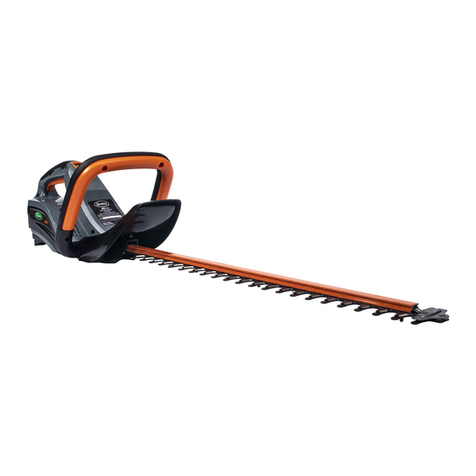
Scotts
Scotts LHT12440S User manual

Scotts
Scotts LHT12462S User manual
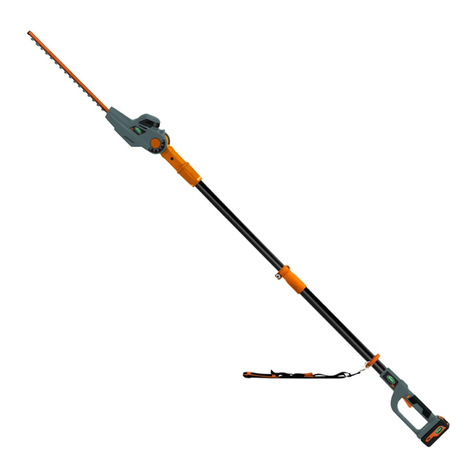
Scotts
Scotts LPHT11724S User manual
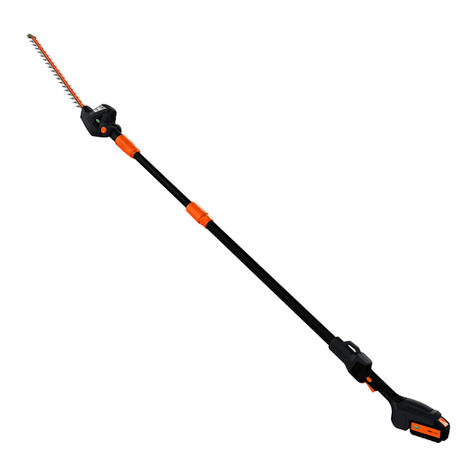
Scotts
Scotts LPHT12122S User manual
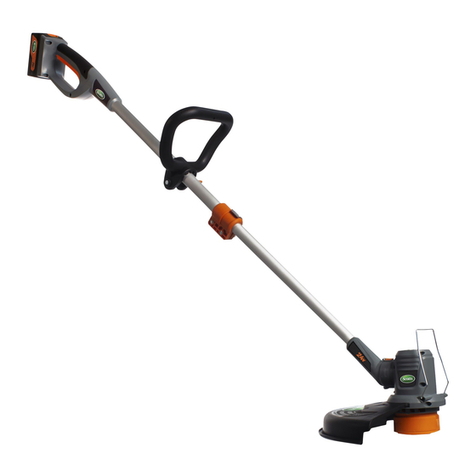
Scotts
Scotts LST01324S User manual
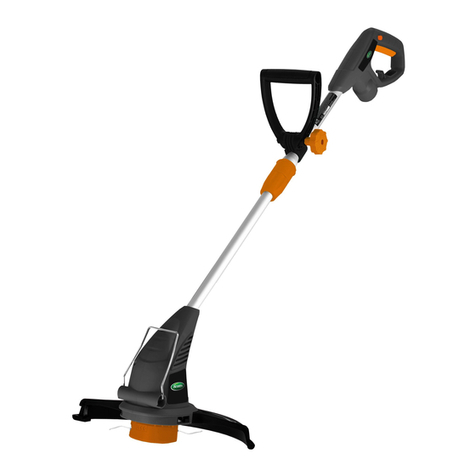
Scotts
Scotts ST00213S User manual

Scotts
Scotts LHT12224S User manual
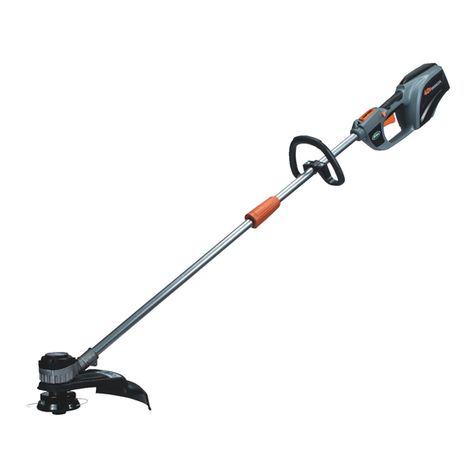
Scotts
Scotts LST01540S User manual
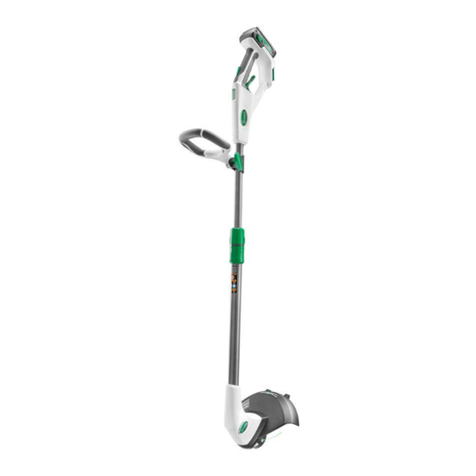
Scotts
Scotts S20200 User manual
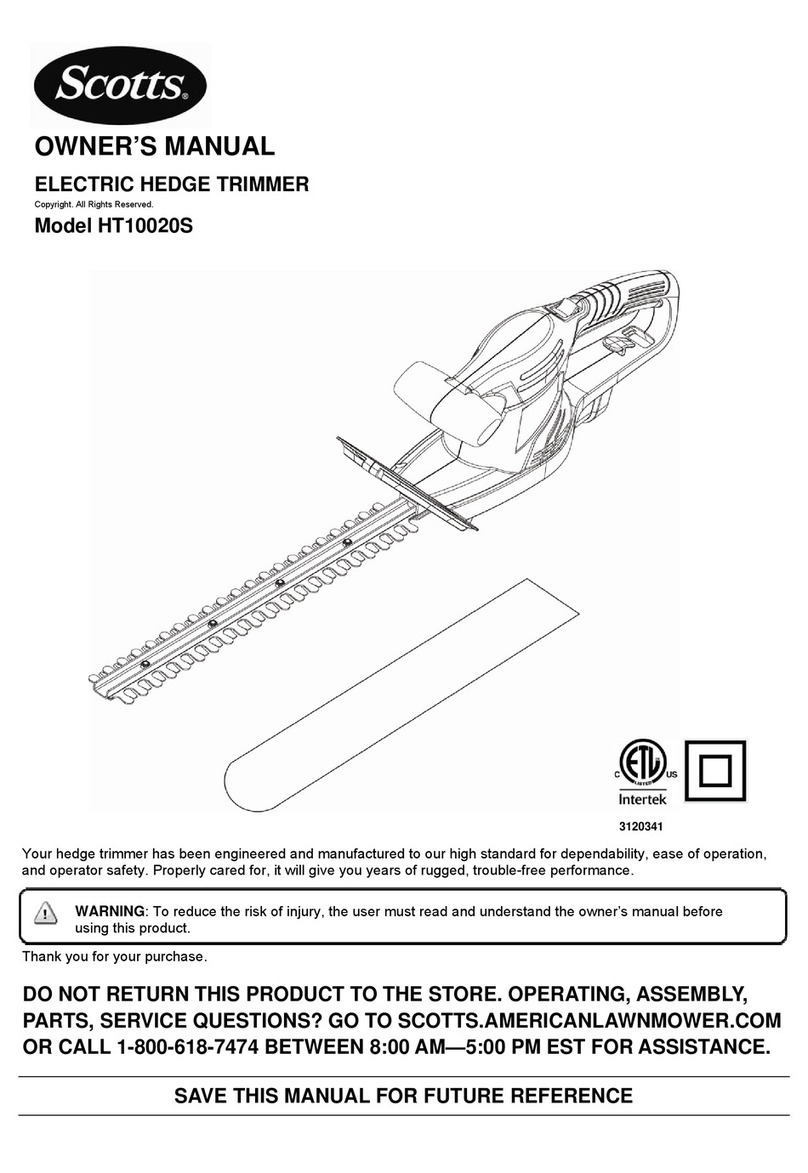
Scotts
Scotts HT10020S User manual
